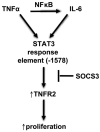Cytokine induction of tumor necrosis factor receptor 2 is mediated by STAT3 in colon cancer cells
- PMID: 21994466
- PMCID: PMC3243771
- DOI: 10.1158/1541-7786.MCR-10-0210
Cytokine induction of tumor necrosis factor receptor 2 is mediated by STAT3 in colon cancer cells
Abstract
The IL-6/STAT3 and TNFα/NFκB pathways are emerging as critical mediators of inflammation-associated colon cancer. TNF receptor (TNFR) 2 expression is increased in inflammatory bowel diseases, the azoxymethane/dextran sodium sulfate (AOM/DSS) model of colitis-associated cancer, and by combined interleukin (IL) 6 and TNFα. The molecular mechanisms that regulate TNFR2 remain undefined. This study used colon cancer cell lines to test the hypothesis that IL-6 and TNFα induce TNFR2 via STAT3 and/or NFκB. Basal and IL-6 + TNFα-induced TNFR2 were decreased by pharmacologic STAT3 inhibition. NFκB inhibition had little effect on IL-6 + TNFα-induced TNFR2, but did inhibit induction of endogenous IL-6 and TNFR2 in cells treated with TNFα alone. Chromatin immunoprecipitation (ChIP) revealed cooperative effects of IL-6 + TNFα to induce STAT3 binding to a -1,578 STAT response element in the TNFR2 promoter but no effect on NFκB binding to consensus sites. Constitutively active STAT3 was sufficient to induce TNFR2 expression. Overexpression of SOCS3, a cytokine-inducible STAT3 inhibitor, which reduces tumorigenesis in preclinical models of colitis-associated cancer, decreased cytokine-induced TNFR2 expression and STAT3 binding to the -1,578 STAT response element. SOCS3 overexpression also decreased proliferation of colon cancer cells and dramatically decreased anchorage-independent growth of colon cancer cells, even cells overexpressing TNFR2. Collectively, these studies show that IL-6- and TNFα-induced TNFR2 expression in colon cancer cells is mediated primarily by STAT3 and provide evidence that TNFR2 may contribute to the tumor-promoting roles of STAT3.
Figures







Similar articles
-
Suppressor of cytokine signaling 3 (SOCS3) limits damage-induced crypt hyper-proliferation and inflammation-associated tumorigenesis in the colon.Oncogene. 2007 Jul 19;26(33):4833-41. doi: 10.1038/sj.onc.1210286. Epub 2007 Feb 12. Oncogene. 2007. PMID: 17297444
-
Tumor necrosis factor (TNF) alpha increases collagen accumulation and proliferation in intestinal myofibroblasts via TNF receptor 2.J Biol Chem. 2005 Oct 28;280(43):36099-109. doi: 10.1074/jbc.M505291200. Epub 2005 Sep 1. J Biol Chem. 2005. PMID: 16141211
-
A signal transducer and activator of transcription 3·Nuclear Factor κB (Stat3·NFκB) complex is necessary for the expression of fascin in metastatic breast cancer cells in response to interleukin (IL)-6 and tumor necrosis factor (TNF)-α.J Biol Chem. 2014 Oct 24;289(43):30082-9. doi: 10.1074/jbc.M114.591719. Epub 2014 Sep 11. J Biol Chem. 2014. PMID: 25213863 Free PMC article.
-
Tumor necrosis factor and stroke: role of the blood-brain barrier.Prog Neurobiol. 2007 Dec;83(6):363-74. doi: 10.1016/j.pneurobio.2007.07.008. Epub 2007 Aug 6. Prog Neurobiol. 2007. PMID: 17913328 Free PMC article. Review.
-
Inflammation and oncogenesis: a vicious connection.Curr Opin Genet Dev. 2010 Feb;20(1):65-71. doi: 10.1016/j.gde.2009.11.004. Epub 2009 Dec 25. Curr Opin Genet Dev. 2010. PMID: 20036794 Free PMC article. Review.
Cited by
-
IP6 reduces colorectal cancer metastasis by mediating the interaction of gut microbiota with host genes.Front Nutr. 2022 Sep 2;9:979135. doi: 10.3389/fnut.2022.979135. eCollection 2022. Front Nutr. 2022. PMID: 36118769 Free PMC article.
-
Combination of metformin and 5-aminosalicylic acid cooperates to decrease proliferation and induce apoptosis in colorectal cancer cell lines.BMC Cancer. 2016 Feb 19;16:126. doi: 10.1186/s12885-016-2157-9. BMC Cancer. 2016. PMID: 26896068 Free PMC article.
-
Primary skeletal muscle myoblasts from chronic heart failure patients exhibit loss of anti-inflammatory and proliferative activity.BMC Cardiovasc Disord. 2016 May 26;16:107. doi: 10.1186/s12872-016-0278-3. BMC Cardiovasc Disord. 2016. PMID: 27228977 Free PMC article.
-
STAT3 Target Genes Relevant to Human Cancers.Cancers (Basel). 2014 Apr 16;6(2):897-925. doi: 10.3390/cancers6020897. Cancers (Basel). 2014. PMID: 24743777 Free PMC article.
-
Immune profiling of human vestibular schwannoma secretions identifies TNF-α and TWEAK as cytokines with synergistic potential to impair hearing.J Neuroinflammation. 2025 Feb 8;22(1):35. doi: 10.1186/s12974-025-03364-z. J Neuroinflammation. 2025. PMID: 39923035 Free PMC article.
References
-
- Ekbom A, Helmick C, Zack M, Adami HO. Ulcerative colitis and colorectal cancer. A population-based study. N Engl J Med. 1990;323:1228–33. - PubMed
-
- Ekbom A, Helmick C, Zack M, Adami HO. Increased risk of large-bowel cancer in Crohn's disease with colonic involvement. Lancet. 1990;336:357–9. - PubMed
-
- Munkholm P. Review article: the incidence and prevalence of colorectal cancer in inflammatory bowel disease. Alimentary Pharmacology & Therapeutics. 2003;18 2:1–5. - PubMed
-
- Becker C, Fantini MC, Wirtz S, Nikolaev A, Lehr HA, Galle PR, Rose-John S, Neurath MF. IL-6 signaling promotes tumor growth in colorectal cancer. CellCycle. 2005;4:217–20. - PubMed
-
- Corvinus FM, Orth C, Moriggl R, Tsareva SA, Wagner S, Pfitzner EB, Baus D, Kaufmann R, Huber LA, Zatloukal K, Beug H, Ohlschlager P, Schutz A, Halbhuber KJ, Friedrich K. Persistent STAT3 activation in colon cancer is associated with enhanced cell proliferation and tumor growth. Neoplasia (New York, NY) 2005;7:545–55. - PMC - PubMed
Publication types
MeSH terms
Substances
Grants and funding
LinkOut - more resources
Full Text Sources
Molecular Biology Databases
Miscellaneous

